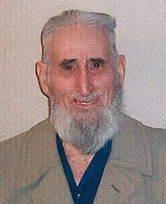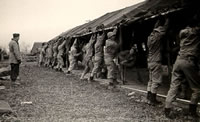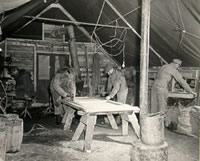Randal Luscombe, Technician Fifth Grade, Utility Shop
John L. Guerrant | Hubert B. Holsinger | Alice M. Huffman | Frank L. Lowther | Randal Luscombe | Dorothy Sandridge | Melvin C. Shaffer | William P. Snavely | Beverley D. Tucker | Frances E. Wells | 8th EVAC home

Randal Luscombe, February 22, 2000
Randal Luscombe was born in Iowa in September 1914. He was a farmer in the Midwest when he was drafted. He learned his metal working skills, which were of great importance to the 8th Evac, as a young man watching and helping blacksmiths in their shops. After the war he married Berneice Payton, settled in Iowa, and then moved to Missouri, where he raised hogs and cattle, and grew corn, beans, and alfalfa. He used the knowledge he gained about sanitation at the 8th Evac to breed disease-free animals. He was a member of the American Legion and Veterans of Foreign Wars. He died in May 2004.
The following is taken from telephone conversations with Mr. Luscombe on August 22, August 30, September 6, and September 13, 2000.
Mr. Luscombe expanded on the story in Dr. Byrd Leavell’s book, The 8th Evac, concerning a fence Luscombe was building at Leavell’s request. As told in the book, the breakfast conversation one morning included:
“Yes, Luscombe is a remarkable fellow.”
“Yes.”
“The first time I had anything to do with Luscombe was when we were on the advance party at Teano. I was telling him how I wanted a fence built, marking it off and all that. He said, ‘Captain, you don’t have to tell me a thing. I’ve been building fences all my life; there’s nobody that can build a straighter fence than I can. You go and do something else. I’ll build the fence, and it will be a helluva lot better than anything you have in mind.’ He did, too.”
Mr. Luscombe added that Dr. Leavell had been talking to him about the fence and was holding on to the side of a fencepost which was to be pounded into the ground. About the time that Mr. Luscombe started the swing of his sledgehammer, Dr. Leavell moved a hand to the top of the post. Mr. Luscombe was able to miss the post and hand only by altering, not stopping, his swing. He nearly hit his own toe as the sledgehammer smashed into the ground. That was when he suggested Dr. Leavell leave the fence building to him.
Mr. Luscombe also remembered the trip across northern Africa from Casablanca to Algiers. The officers and nurses traveled in the coach cars of a train while the enlisted men ended up in cattle cars. Mr. Luscombe said that it turned out that the enlisted men were fortunate to be in the cattle cars as the coach cars were infested with bed bugs. Landing in Italy resulted in more discomfort for the 8th Evac. Mr. Luscombe recalled being very hungry for several days. When asked why, he said that the ammunition had to come in first, even before food.

Randal Luscombe directing the pitching of a tent with the newly designed frame
Mr. Luscombe used his knowledge about blacksmithing throughout the war, and worked closely with Colonel Harris Holmboe. The two men would get together for what they called a brainstorm. One of the most useful sessions involved tent frames. Colonel Holmboe asked Mr. Luscombe if he could design a new frame that would eliminate poles coming to the ground in the central areas of the surgery tent to make it less awkward to work. Colonel Holmboe also was concerned about the wind whipping the canvas which stirred up dust. Mr. Luscombe thought about it for a day or two, and Colonel Holmboe retrieved some old poles from the salvage yard. The two of them went over plans Mr. Luscombe had drawn up, and Colonel Holmboe said to give it a try. It worked out so well that eventually Mr. Luscombe made not only the tent frame for surgery, but also four others.
Mr. Luscombe designed and made adjustable IV stands that could accommodate fluid containers for two patients. They were ideal for a hospital that moved frequently because once the three removable legs were detached, they would fold flat. He also made adjustable stands and removable trays to hold the instrument bundles for the surgeons. Keeping in mind the frequent moves, the stands were stackable.
Colonel Holmboe asked Mr. Luscombe if he could design a test tube holder that would withstand the heat and moisture of an autoclave. Mr. Luscombe went to the mess hall to find material he could use. He saw a five gallon bucket and asked for it. Using an iron punch which he fashioned, he made holes in the tin, repeated the process in another piece of tin, and had a test tube holder that lasted as long as the unit needed it.

The Utility Section of the 8th Evac: Carpentry, Welding and Blacksmithing
Mr. Luscombe said he never worked so hard in his life as when he was with the 8th Evac, but that everything he did was to help the patients. His admiration for the doctors was clear. He said, “I don’t know how the doctors stood up under pressure—all day, all night, all day and more if they needed to.” He remembered one day watching Colonel Holmboe and three officers conversing outside the area where he worked. Although it was a nice day, not too hot and not too cold, the men were wiping their brows with handkerchiefs. Colonel Holmboe told Mr. Luscombe later that the doctors were discussing what to do with patients with gangrene. Penicillin was newly available but the proper dosage was unclear. Mr. Luscombe said that he knew what he would do–give some patients a lot of penicillin and some a little and see what happened. He did not know what the doctors decided to do, but the men stopped dying.
Colonel Holmboe frequently visited Mr. Luscombe’s work area. Mr. Luscombe was accustomed to directing him to do an about-face if there were a chance of hot flakes flying off as he worked on his metal. Colonel Holmboe did not question the instruction from an enlisted man once he understood the danger the metal posed to his eyes. One day Colonel Holmboe arrived, and Mr. Luscombe instructed him to turn around while he finished working on a piece of hot iron. Colonel Holmboe immediately turned as did the two men with him. Mr. Luscombe recalled that he felt like sinking into the earth as soon as he realized that the two men were Lieutenant General Mark Clark, commanding general of the 5th Army and Brigadier General Joseph Martin, 5th Army surgeon. After leaving the work area, one of the generals asked Colonel Holmboe what that episode was all about. He responded, “Don’t want to lose an eye, do you?”
John L. Guerrant | Hubert B. Holsinger | Alice M. Huffman | Frank L. Lowther | Randal Luscombe | Dorothy Sandridge | Melvin C. Shaffer | William P. Snavely | Beverley D. Tucker | Frances E. Wells | 8th EVAC home